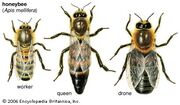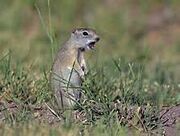
We have talked so much about altruism and so I wanted to dig a little deeper into the idea of "Inclusive Fitness." While there is an element of altruism, I needed to really try to understand what inclusive fitness was and is, especially since the word fitness has so many different definitions in evolution. Inclusive fitness is essentially, how many of your own offspring you can produce and support, improving your genetic success through cooperative behavior. This means that you're not just exhibiting altruistic behavior to your immediate kin, but all blood kin, maximizing the number of copies of yourself in the population. Essentially, you do what it takes to promote the reproduction and survival of all your kin.

Shed Science Inclusive fitness and why Hamilton rules!
Shed Science on Inclusive fitness
From Darwin to Hamilton to Price[]
Charles Darwin was baffled by the behavior of bees that would give up their lives for the betterment of the hive. Upon seeing this behavior, he thought that "natural selection might favor altruism at the level of blood kin (Dugatkin, 2007). He was intrigued by this level of sacrifice, and went on to discuss it in On the Origin of Species. Later, Thomas Huxley and Peter Kropotkin would take up the argument regarding altruism at the blood level - but it was not based at all in research, just theory and readings. As time passed, more and more researchers came close to the idea of inclusive fitness, but fell just short of the mark. What was frustrating was that all of these mathematical population models were being built, but they didn't make the genetic step linking kinship and altruism. Enter Bill Hamilton - a student at Cambridge who became fascinated with the idea of altruism. In his first paper, published in 1963, Hamilton shared these groundbreaking thoughts: "It is generally accepted that the behaviour characteristic of a species is just as much the product of evolution as the morphology...in particular - any case where an animal behaves in such a way as to promote the advantages of other members of the species not its direct descendants at the expense of its own (Dugatkin, 2007)." This is where the actual cost/benefit analysis of altruism finally came about. Unfortunately not many paid much attention to the discovery of Bill Hamilton - until George Price. After reading all of Hamilton's work, and double checking the math, he determined that everything was correct - giving Price the opportunity to study not only altruistic behavior, but spiteful behavior as well. Price discovered that in groups with many blood kin, a gene for altruism had a positive covariance with the number of offspring. Conversly, he also discovered that in groups with less relatedness, spiteful behavior may become prevalent. Today, Bill Hamilton's work is the the seminal theory behind inclusive fitness.
Resource:
Dugatkin, L. (2007) Inclusive fitness theory from Darwin to Hamilton. Genetics, 176, 1375-130.
Not all is well in inclusive fitness land[]
So this idea of inclusive fitness did not end with Hamilton's work - it has continued throughout the years,with many conflicting ideas and thoughts. A recent paper written by Martin Nowak, Corina Tarnita and Edward Wilson titled "The evolution of eusociality" was published questioning the validity of kin selection as the explanation of eusociality - colonies of organisms that seem to act in a unified fashion. Basically, in eusocial communities, there are those that sacrifice their reproduction to assist in the care and guarding of their siblings or kin. The trio of Nowak, Tarnita and Wilson say the idea of inclusive fitness is flawed, and have set about proving it is invalid. Questions have arisen about those bees or insects that do not reproduce, but work for the good of the group, or the Beldings ground squirrel population, who as a sentry will put one member in harm's way to protect the rest of the group, thus keeping the maximum amount of kin alive. Recently a series of responses to Nowak, Tamita and Wilson were published by Macmillan Publishers in Nature. Check out the link below for more info on this on-going and heated argument.

Resources:
Jensen, C. (2010) Robert Trivers and colleagues on Nowak, Tarnita and Wilson's "The evolution of eusociality." Retrieved from http://www.christopherxjjensen.com/2010/10/13/robert-trivers-and-colleagues-on-nowak-tarnita-and-wilsons-the-evolution-of-eusociality/
Nowak, M., Tarnita, C., & Wilson, E. (2010) The evolution of eusociality. Nature, 466(7310), 1057-1062. http://www.ncbi.nlm.nih.gov/pmc/articles/PMC3279739/
Multiple authors and responses to the paper by Nowak, Tarnita, and Wilson. http://faculty.bennington.edu/~sherman/animal%20social%20beh/Inclusive%20fitness%20theory%20and%20eusociality.pdf